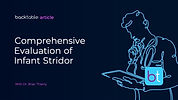BackTable / ENT / Podcast / Episode #141
Stridor in Newborns: Evaluation & Management
with Dr. Briac Thierry
In this episode of BackTable ENT, Dr. Gopi Shah and Dr. Briac Thierry, Pediatric ENT at Necker Hospital for Sick Children in Paris, France, review stridor in newborns, with a special emphasis on laryngomalacia.
Be part of the conversation. Put your sponsored messaging on this episode. Learn how.

BackTable, LLC (Producer). (2023, November 7). Ep. 141 – Stridor in Newborns: Evaluation & Management [Audio podcast]. Retrieved from https://www.backtable.com
Stay Up To Date
Follow:
Subscribe:
Sign Up:
Podcast Contributors
Synopsis
First, Briac and Gopi discuss how a newborn with stridor can present. Though stridor does occur among NICU babies, most of Briac’s patients are referred by outpatient pediatricians. They discuss a list of questions to ask while taking a history and emphasize the importance of assessing growth trends. In the absence of other medical problems, declining weight can suggest severe aerodigestive tract abnormality. Any pathology that narrows the airway can cause stridor: in infants, these include laryngomalacia, vallecular cysts, subglottic cysts, tracheal rings, and bilateral vocal fold immobility.
Then, Briac talks listeners through his physical exam, with special attention paid to flexible fiberoptic laryngoscopy. Briac shares his tips to maximize visualization and clinician ergonomics when scoping a small child. If bilateral vocal fold immobility is suspected, Briac recommends performing a longer fiberoptic exam so that the clinician can determine whether vocal fold immobility is present at rest or due to an uncomfortable child crying.
Next, Gopi and Briac differentiate between mild, moderate, and severe laryngomalacia and the indications for going to the operating room for an airway evaluation. As 20% of children with laryngomalacia have secondary airway lesions, a meticulous laryngoscopy/bronchoscopy is mandatory in these patients when a trip to the OR is required. Moving to the OR, Briac talks about his workflow when performing diagnostic bronchoscopy/laryngoscopy (DLB) to assess various causes of stridor. The episode concludes with Briac’s meditations on airway surgery as a team endeavor.
Resources
Briac’s Necker Hospital Profile:
https://www.aphp.fr/offre-de-soin/medecin/3168653/061/16
International Pediatric ORL Group (IPOG) Laryngomalacia Consensus Recommendations:
https://www.sciencedirect.com/science/article/abs/pii/S0165587616300519
Pediatric Airway Channel in Paris (@voies_aeriennes):
https://www.youtube.com/@voies_aeriennes
Transcript Preview
[Dr. Gopi Shah]
All right. Today we're going to talk about the newborn who presents with a stridor. How do they usually present to you? How much of the time do you see these patients in your clinic and how often is it a consult in the hospital for you?
[Dr. Briac Thierry]
I think most of the time it's in the clinic and they are referred to my consultation from the pediatrician. A few times, they are referred into the hospital and they are in NICU or PICU. This is not the most frequent time. We are going to talk definitely about stridor and laryngomalacia and the most frequent is laryngomalacia in the clinic.
The Materials available on BackTable are for informational and educational purposes only and are not a substitute for the professional judgment of a healthcare professional in diagnosing and treating patients. The opinions expressed by participants of the BackTable Podcast belong solely to the participants, and do not necessarily reflect the views of BackTable.
















